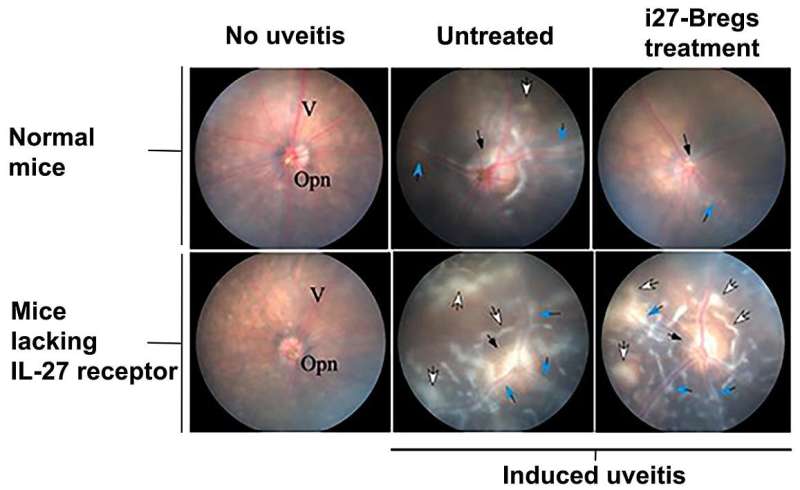Discovering a new B cell that tempers autoimmunity

Researchers at the National Eye Institute (NEI) have identified, isolated, and characterized a unique population of B cells that tamps down the immune system, reducing chronic inflammation. Infusions of purified IL-27 regulatory B cells (I27-Breg ) reduced symptoms in mouse models of multiple sclerosis (MS) and the eye disease autoimmune uveitis. The research suggests the cells may play a role in future human therapies. NEI is part of the National Institutes of Health.
“We are the first to describe this unique population of regulatory B cells. While similar in function to other Bregs, I27-Breg have a distinct gene expression profile and originate from the innate B-1a cell lineage,” said Charles Egwuagu, Ph.D., M.P.H., who directs the NEI Molecular Immunology Section. He and colleagues published their findings in PNAS.
Uveitis is a group of sight-threatening inflammatory eye diseases that includes Behcet disease, birdshot retinochoroidopathy, and sympathetic ophthalmia. Of infectious or autoimmune origin, it is characterized by repeated cycles of intraocular inflammation. Current therapies include corticosteroids; however, prolonged use of these drugs risks other eye problems such as optic neuropathy andsteroid-induced glaucoma.
Regulatory B cells (Bregs) are a newly designated B-cell subset that plays a pivotal role in regulating inflammation, autoimmunity, and cancer. They represent a small fraction of the body’s B cell population, which patrols the blood for invading pathogens. The principal function of Bregs is in modulating the immune system through expression of various signaling cytokines, such as IL-10 and IL-35, which put the brakes on chronic inflammation. Bregs counterbalance physiological effects of pro-inflammatory cytokines such as IFN-gamma and IL-17. Thus, a healthy balance of pro- and anti-inflammatory cytokines ensures a robust immune response to pathogens while preventing excessive proinflammatory cytokines, which can damage tissues and cause autoimmune disease.
Scientists discovered Bregs when treating rheumatoid arthritis with Rituximab, an anti-CD20 monoclonal antibody. Rituximab depleted B cells expressing the B-lymphocyte antigen CD20, which is on all B cells except plasma blasts or plasma cells. As most Bregs derive from plasma blasts or plasma cell, CD20 depletion led to expansion and eventual discovery of IL-10 secreting B cells (IL-10 Bregs) that exhibit anti-inflammatory characteristics.
In 2014, the Egwuagu lab reported the discovery of another anti-inflammatory Breg, which releases IL-35. They showed that i35-Bregs suppress central nervous system (CNS) autoimmune disease by inducing expansion of IL-10 Bregs. Paired with 2007 findings, in which they showed that IL-27 increases IL-27 expression by retinal cells in response to inflammation, and that IL-27 and IL-35 are structurally and functionally similar, Egwuagu posited the existence of an IL-27-secreting B-cell population.
Egwuagu and colleagues used a variety of assays to demonstrate the existence of IL-27-producing regulatory B cells (i27-Bregs) in the peritoneal cavity of mice. Further analyses showed that upon encounter with innate immune stimuli, the cells , which come from B-1a lineage B cells, lose their ability to produce natural IgM antibodies and differentiate into IL-27-producing B-1a cells. They then migrate from the peritoneal cavity to secondary lymphoid tissues such as the spleen. The researchers also found significant amount of i27-Bregs in human umbilical cord blood.
The researchers next examined whether i27-Breg immunotherapy would be effective in suppressing autoimmune uveitis or a multiple sclerosis (MS)-like disease in mice. Infusion of purified i27-Breg ameliorated uveitis and MS through up-regulation of inhibitory receptors (Lag3, PD-1), suppression of T-cell (Th17/Th1) responses, and propagation of inhibitory signals that converted conventional B cells to regulatory lymphocytes that secrete IL-10 and/or IL-35 in eye, brain, and spinal cord. Additionally, they found that i27-Bregs proliferate in vivo and sustain IL-27 secretion in CNS and lymphoid tissues, a therapeutic advantage over administering IL-10 or IL-35 biologics, which are rapidly cleared in the body. i27-Breg infusions into mice lacking the IL-27 receptor failed to attenuate disease symptoms, demonstrating that IL-27 is necessary for successful treatment. i27-Bregs are neither antigen-specific nor disease-specific, suggesting that they would be effective immunotherapy for a wide spectrum of autoimmune diseases.
“Whereas i35-Breg and i27-Breg have similar functions, i27-Breg may have greater therapeutic potential,” said Jin Kyeong Choi, Ph.D., a former NEI postdoctoral fellow now at Jeonbuk National University, South Korea, and first author on the paper. “i27-Breg can proliferate after they’re injected, unlike i35-Bregs, which stop dividing when mature. In addition, i27-Breg more quickly respond to autoimmune disease.”
Source: Read Full Article



